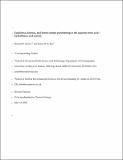Files in this item
Equilibria, kinetics, and boron isotope partitioning in the aqueous boric acid–hydrofluoric acid system
Item metadata
| dc.contributor.author | Zeebe, Richard | |
| dc.contributor.author | Rae, James W. B. | |
| dc.date.accessioned | 2021-06-04T23:45:24Z | |
| dc.date.available | 2021-06-04T23:45:24Z | |
| dc.date.issued | 2020-09-20 | |
| dc.identifier | 268574049 | |
| dc.identifier | 7b62612f-a719-4397-b2a4-d6e064fd620f | |
| dc.identifier | 85086583516 | |
| dc.identifier | 000562695700010 | |
| dc.identifier.citation | Zeebe , R & Rae , J W B 2020 , ' Equilibria, kinetics, and boron isotope partitioning in the aqueous boric acid–hydrofluoric acid system ' , Chemical Geology , vol. 550 , 119693 . https://doi.org/10.1016/j.chemgeo.2020.119693 | en |
| dc.identifier.issn | 0009-2541 | |
| dc.identifier.other | ORCID: /0000-0003-3904-2526/work/75996887 | |
| dc.identifier.uri | https://hdl.handle.net/10023/23312 | |
| dc.description | REZ is grateful to Lance Agavulin and Glen Morangie for their spiritual support. JWBR was supported by the European Research Council (ERC Grant 805246) and the Natural Environment Research Council (NERC grant NE/N011716/1). | en |
| dc.description.abstract | The aqueous boric, hydrofluoric, and fluoroboric acid systems are key to a variety of applications, including boron measurements in marine carbonates for CO2 system reconstructions, chemical analysis and synthesis, polymer science, sandstone acidizing, fluoroborate salt manufacturing, and more. Here we present a comprehensive study of chemical equilibria and boron isotope partitioning in the aqueous boric acid–hydrofluoric acid system. We work out the chemical speciation of the various dissolved compounds over a wide range of pH, total fluorine (FT), and total boron (BT) concentrations. We show that at low pH (0 ≤ pH ≤ 4) and FT ≫ BT, the dominant aqueous species is BF4−, a result relevant to recent advances in high precision measurements of boron concentration and isotopic composition. Using experimental data on kinetic rate constants, we provide estimates for the equilibration time of the slowest reaction in the system as a function of pH and [HF], assuming FT ≫ BT. Furthermore, we present the first quantum-chemical (QC) computations to determine boron isotope fractionation in the fluoroboric acid system. Our calculations suggest that the equilibrium boron isotope fractionation between BF3 and BF4− is slightly smaller than that calculated between B(OH)3 and B(OH)4−. Based on the QC methods X3LYP/6-311+G(d,p) (X3LYP+) and MP2/aug-cc-pVTZ (MP2TZ), α(BF3−BF4−) ≃ 1.030 and 1.025, respectively. However, BF4− is enriched in 11B relative to B(OH)4−, i.e., α(BF4−−B(OH)4−) ≃ 1.010 (X3LYP+) and 1.020 (MP2TZ), respectively. Selection of the QC method (level of theory and basis set) represents the largest uncertainty in the calculations. The effect of hydration on the calculated boron isotope fractionation turned out to be minor in most cases, except for BF4− and B(OH)3. Finally, we provide suggestions on best practice for boric acid–hydrofluoric acid applications in geochemical boron analyses. | |
| dc.format.extent | 470059 | |
| dc.language.iso | eng | |
| dc.relation.ispartof | Chemical Geology | en |
| dc.subject | Isotopic and elemental geochemistry | en |
| dc.subject | Boron isotopes | en |
| dc.subject | pH proxy | en |
| dc.subject | Analytical and theoretical advances | en |
| dc.subject | Aqueous boric acid-hydrofluoric acid system | en |
| dc.subject | GE Environmental Sciences | en |
| dc.subject | QE Geology | en |
| dc.subject | DAS | en |
| dc.subject | SDG 14 - Life Below Water | en |
| dc.subject.lcc | GE | en |
| dc.subject.lcc | QE | en |
| dc.title | Equilibria, kinetics, and boron isotope partitioning in the aqueous boric acid–hydrofluoric acid system | en |
| dc.type | Journal article | en |
| dc.contributor.sponsor | European Research Council | en |
| dc.contributor.sponsor | NERC | en |
| dc.contributor.institution | University of St Andrews. School of Earth & Environmental Sciences | en |
| dc.contributor.institution | University of St Andrews. St Andrews Isotope Geochemistry | en |
| dc.identifier.doi | https://doi.org/10.1016/j.chemgeo.2020.119693 | |
| dc.description.status | Peer reviewed | en |
| dc.date.embargoedUntil | 2021-06-05 | |
| dc.identifier.grantnumber | 805246 | en |
| dc.identifier.grantnumber | NE/N011716/1 | en |
This item appears in the following Collection(s)
Items in the St Andrews Research Repository are protected by copyright, with all rights reserved, unless otherwise indicated.

